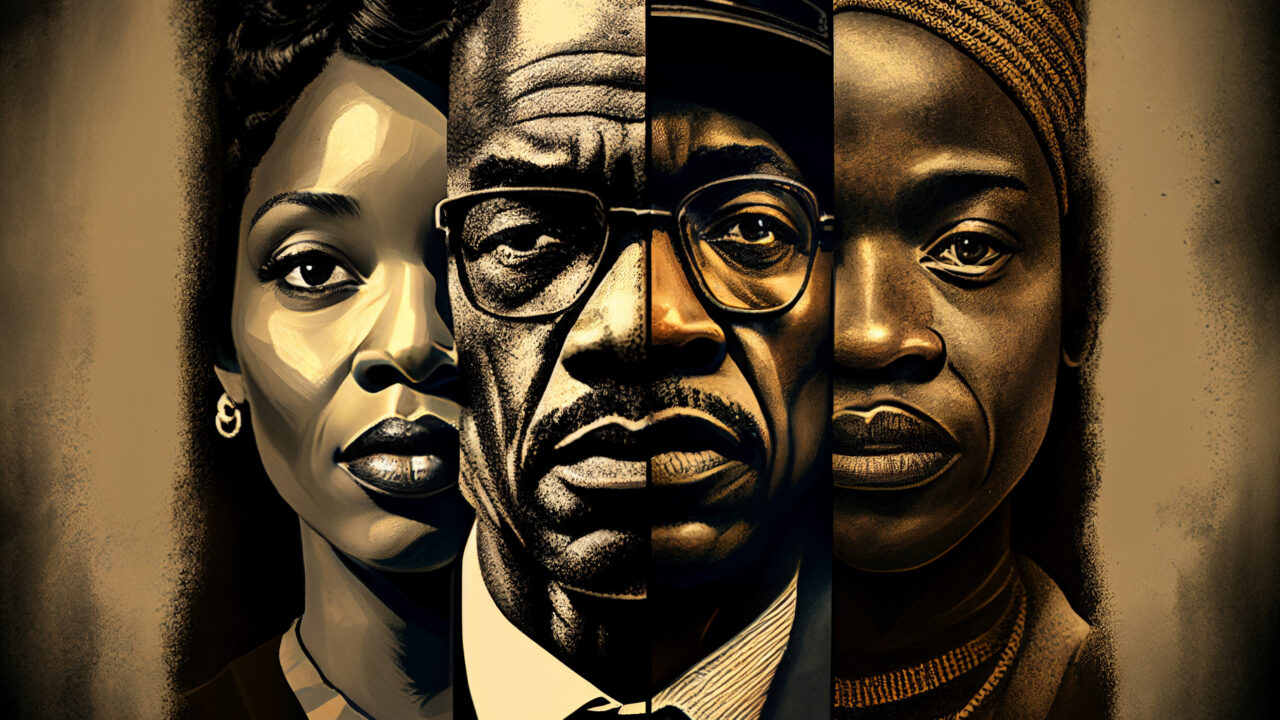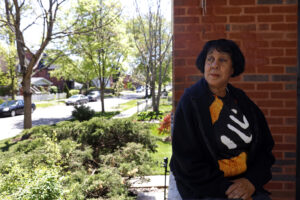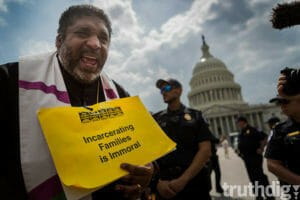Can California Lead the Way on Reparations?
California is closer than any other state to realizing reparations for Black people. Now, the state faces a make-or-break moment. Image: Adobe
Image: Adobe
In his 2020 book, Begin Again, Eddie Glaude Jr.’s meditation on the modern relevance of the writer James Baldwin, Glaude describes how Baldwin returned to the United States from Paris in 1957 to witness a civil rights movement that was seriously getting underway. Traveling through the South, Baldwin was struck by how American life was still defined by a belief in the inferiority of Black people, and further struck by how that enduring lie would likely prevent white people from transforming the nation. He believed that until he died in 1987.
Now, 37 years later, the lie that never went away has enjoyed a remarkable resurgence in U.S. politics, overwhelmingly on the right, that threatens to engulf the whole republic. It has taken the form of attacks on Black history in education, and even the very presence of Black people in positions of power. But something else remarkable is happening that Baldwin could not have imagined at all: The push for reparations—compensation for the damage wrought by hundreds of years of the lies that justified slavery and then segregation and discrimination—has become mainstream.
In 2021, California became the first state to launch a reparations task force, the largest-scale effort to pursue reparations in the country. The task force was born from a 2019 bill introduced by then-assemblywoman Shirley Weber, four months after the death of John Conyers, the Democratic congressman from Michigan who introduced a federal reparations bill, H.R. 40, every year for nearly 30 years. Weber’s bill in California was practically a carbon copy of H.R. 40.
The push for reparations—compensation for the damage wrought by hundreds of years of the lies that justified slavery and then segregation and discrimination—has become mainstream.
Two years after the task force was launched, in summer 2023, it released 1,000-plus pages of more than 100 recommendations based on two years of research, hearings, and discussions. The recommendations were highly anticipated; the executive summary noted that California, as is the case with so much else, expected to serve as a model for how reparations could be realized elsewhere, especially at the federal level.
Despite the historic nature of the report, the future of reparations in the Golden State is far from assured. To begin with, the committee’s findings make clear that California, far from being the exception to racist practices and policies in other states, has been in many ways worse. The Executive Summary echoes Baldwin in bluntly citing “racist lies” underlying attitudes and practices in California that are not just consigned to history but are ongoing. The state tolerated slavery despite being admitted in 1850 as a “free” state, was a hot spot of Klan activity that at one point rivaled the South, and failed to ratify the 14th and 15th amendments until 1959 and 1962, respectively.
More recently, in 2022, the California Senate refused to support a constitutional amendment that would have eliminated slavery and involuntary servitude as punishment for a crime, a step that many other far less progressive states such as Alabama and Tennessee have taken. These facts are but a few of many that beg the question: California may be the first state to formally embark on a project of reparations, but will it actually implement it?
State Sen. Steven Bradford (D-Inglewood), vice chair of the California Legislative Black Caucus, was one of three elected officials on the nine-member reparations task force and has frequently been its public face. He says an agreement on any reparations legislation for Gov. Gavin Newsom to consider will not come until later in 2024. In early February 2024, Black lawmakers unveiled the first set of reparations bills, 14 proposed laws that call for boosting home ownership, property tax relief in redlined communities, and a formal apology from Gov. Newsom for California’s history of anti-Black racism, among other things.
In winter 2023, Bradford proposed SB 490—the first post-task force bill—to establish the California American Freedmen Affairs Agency, an office to oversee reparations distribution that deliberately recalls the Freedman’s Bureau, a Reconstruction-era government body that helped formerly enslaved people transition to freedom. But Bradford cautions that the resulting reparations will take years to become reality, even if the process started today. “It’ll be many legislative cycles, many sessions,” he says. “This is just the beginning.”
Bradford says that the task force’s job since releasing the report has been to convince colleagues in the legislature to read it, or at least familiarize themselves with it. While it sounds like an obvious first step, it’s crucial to changing the reality that Bradford has been acknowledging all along, that there simply isn’t enough support—yet—in California or in the rest of the country, for meaningful reparations for Black people.
The renewed racial consciousness following the police murder of George Floyd in 2020 has popularized the optics of supporting Black people, like taking a knee or putting a Black Lives Matter sign in a window or on a lawn. But grasping the enormity of racism’s legacy and then deciding that something of equal enormity must be done to correct it is another matter. Bradford and his peers face the difficult task of trying to strike a balance between making reparations seem quotidian and common-sense—it is simply giving people what they’re owed—while agitating for nothing less than a revolution of the American psyche. “This is the real stain on America, the sin of slavery,” he says. “Most people don’t understand that most of the wealth in this country is dependent on 400 years of free labor. We still have a racist core.”
While convincing the legislature to educate itself is key, Bradford and others say that there needs to be buy-in from the grassroots as well. The Alliance for Reparations, Reconciliation, and Truth, formed last year, is composed of six former task force members and a growing list of organizations, Black and otherwise, that not only support the full set of task force recommendations but is working to realize them.
Despite the historic nature of the report, the future of reparations in the Golden State is far from assured.
The Legislative Black Caucus is also coordinating its own PR plan. Public opinion of reparations is mixed, especially when it comes to cash compensation. A Berkeley Institute of Governmental Studies poll last year found that while a majority of California voters agree that the legacy of slavery continues to have an impact on the lives of Black residents, less than a third approve of giving money.
The prospect of giving money to Black folks is a conservative lightning rod that has obsessed the media from the start of the state’s reparations process, obscuring the scope of what reparations are, and the many forms they could and should take. Bradford has downplayed the idea of dispensing checks as just one action among many; significantly, the 14 bills introduced in 2024 do not include any calls for cash payments. And yet, payment is the form that reparations have taken for other groups robbed of their wealth over time, such as Jews for the crimes of the Holocaust and the Japanese survivors of internment during World War II. It seems that the biggest challenge for reparations for Black people is the deep-seated belief—the lie—that Black people simply don’t deserve financial compensation, despite overwhelming evidence to the contrary.
Resistance to reparations is also emotional in that it brings to light so much unexamined history. The task force has served as a truth and reconciliation committee that the U.S., including California, has never had. Lisa Holder, another task force member, described California’s recommendations as a “book of truth.” Reluctance to simply explore that truth is long-standing, and legion.
With the California reparations project, the floodgates of truth—if not cash—have opened, a significant step toward redress no matter what happens, or doesn’t, with reparations. San Francisco’s reparations project offers a cautionary tale for the movement for racial repair.
That effort yielded highly ambitious recommendations, also numbering more than a hundred, and spanning finance, housing, and yes, cash payments of $5 million per individual. Other recommendations that came out of San Francisco’s reparations report included creating a public or freedmen’s bank, debt forgiveness, and the formation of a Black reparations trust. But in December 2023, San Francisco Mayor London Breed dropped a bomb when she eliminated from the city budget a relatively paltry $4 million fund for a reparations office—the San Francisco task force’s version of a Freedmen’s Bureau.
Breed has said that true reparations should remain at the federal level, but she also seemed to think it would compete with her Dreamkeeper Initiative, a program aimed at reforming public safety and improving what’s left of Black neighborhoods in San Francisco. The irony was lost on no one, especially the task force: a Black mayor of the country’s most progressive city impeding historic progress for Black people.
And yet Breed is not alone in her reticence. Mandla Kayise, an educational and community planning consultant and a member of the City of Los Angeles Reparations Advisory Commission that formed two years ago, says he’s found that reparations can be a difficult sell—even to Black people. “People should be granted some reasonable skepticism, given the failed history of so many efforts that were supposed to help Black people,” he says. “They just don’t buy it. They don’t think that any of this is going to happen. Only activists and advocates do.” In other words, Black people believe in reparations, but not in the country’s willingness to do the right thing.
“More than informing, it’s about organizing so that we have community pressure to make this happen.”
A bigger problem is that, despite polls showing that a majority of Black people support reparations, there isn’t a lot of awareness about current reparations efforts at the community level. Kayise says the L.A. commission is planning a public roundtable in February with the 60 community organizations it is allied with—churches, nonprofits, individuals—and is looking for more. “We have to fully engage the Black public. That is the overriding factor,” he says. “More than informing, it’s about organizing so that we have community pressure to make this happen.” The L.A. Commission is still in its information-gathering process and expects to release its recommendations by December.
Kayise agrees with Bradford that the inherently controversial nature of reparations, and the sheer scope of it, guarantees it won’t happen quickly. But time is also of the essence: If we can’t make the case and win consensus now, he says, it’ll be harder to do later. Ultimately, what we need, what we’ve always needed, is “national leadership that says, what’s good for Black people is good for us all,” he adds. For all the disillusionment that dogged him to the end of his life, James Baldwin never let go of that idea.
Your support is crucial…With an uncertain future and a new administration casting doubt on press freedoms, the danger is clear: The truth is at risk.
Now is the time to give. Your tax-deductible support allows us to dig deeper, delivering fearless investigative reporting and analysis that exposes what’s really happening — without compromise.
Stand with our courageous journalists. Donate today to protect a free press, uphold democracy and unearth untold stories.






Reparations would be an utter disaster for the US.
It would pit every grievance anyone and any group has against everyone else and each other and be an open invite for corruption and scamming the public, almost all of whom have had no personal part in causing the original harm, many of whom are likely to be worse off than the 'victims'.
This proposed nonsense is what happens when victim-hood becomes validated as an...
Reparations would be an utter disaster for the US.
It would pit every grievance anyone and any group has against everyone else and each other and be an open invite for corruption and scamming the public, almost all of whom have had no personal part in causing the original harm, many of whom are likely to be worse off than the 'victims'.
This proposed nonsense is what happens when victim-hood becomes validated as an identity rather than a personal responsibility.
Fair 'reparations' to address the vast income and wealth inequality we have in the US. would have to be based on poverty, (not race, gender or ethnicity), job opportunities, stronger labor rights, and undoing regressive taxation.